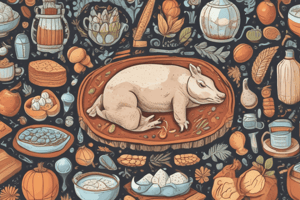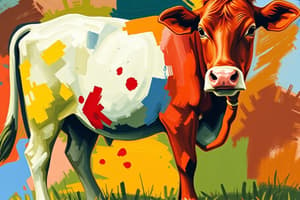Podcast
Questions and Answers
What is the primary characteristic of bulky feeds?
What is the primary characteristic of bulky feeds?
- High in fibre and low digestability (correct)
- High in fibre and low in fibre
- Low in fibre and high digestability
- High in protein and low in fibre
What is the purpose of a maintenance diet?
What is the purpose of a maintenance diet?
- To reduce the fat reserves of an animal
- To produce 1kg of LWG or 1L of milk
- To allow an animal to maintain a constant body weight (correct)
- To promote weight gain
What is the conformation shape of beef breeds?
What is the conformation shape of beef breeds?
- Circular
- Rectangular
- Triangular
- Block shaped (correct)
What is the purpose of a body condition score?
What is the purpose of a body condition score?
What is one of the freedoms in animal welfare?
What is one of the freedoms in animal welfare?
What type of feed is high in protein?
What type of feed is high in protein?
What is a notifiable disease?
What is a notifiable disease?
What is the purpose of a productive diet?
What is the purpose of a productive diet?
Study Notes
Animal Nutrition, Feed, and Ration
- Bulky feeds: high in fiber, low in protein, and have high water content, e.g., grass, silage, hay, and forage crops
- Concentrates: low in fiber, high in protein, and have low water content, e.g., meal, oats, barley, wheat, cereals, maize, and molasses
- Bulky feeds maintain weight, while concentrates promote weight gain due to high energy and sugar content
Types of Diets
- Maintenance diet: the amount of feed required to maintain a constant body weight
- Productive diet: the extra amount of feed required to produce 1kg of live weight gain (LWG), 1L of milk, 1kg of wool, or to produce a calf or lamb
Animal Conformation
- Beef breeds: block-shaped conformation, wide shoulders, and well-fleshed hindquarters, with a focus on muscle and thickness
- Dairy breeds: triangular-shaped conformation, narrow shoulders, and large hindquarters, with a focus on milk production
Body Condition Scoring (BCS)
- A scale from 1-5 to assess the level of fat reserves in cattle, sheep, and pigs
- Proper BCS is required for animal reproduction, milk production, and fat for slaughter
Welfare of Animals
- Freedom from:
- Hunger, thirst, and malnutrition: access to fresh food and water
- Discomfort: provision of shelter and comfortable resting area
- Pain, injury, and disease
- Fear and distress: avoidance of animal mental stress
- Expression of normal behavior: proper space, facilities, and company of other animals
Notifiable Diseases
- Diseases that must be reported to the district veterinary office
- Infectious diseases: caused by micro-organisms or other agents that enter the body
- Contagious diseases: easily transmitted by contact through bodily fluids or contamination
- Zoonoses: diseases and infections transmitted between vertebrate animals and humans, e.g., brucellosis and Rabies
Studying That Suits You
Use AI to generate personalized quizzes and flashcards to suit your learning preferences.
Description
Test your knowledge on animal nutrition, including bulky feeds, concentrates, and the characteristics of different feed types.




